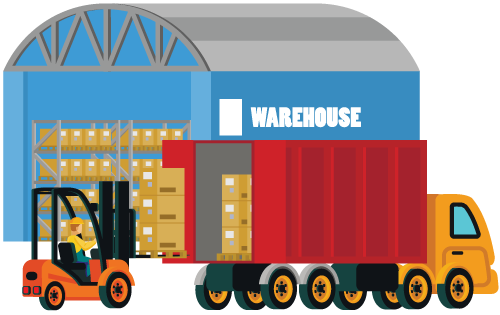What is Picking and Packing?
Built For


Matt Allen, Account Executive at Acctivate inventory software discusses the picking and packing process and its importance in ensuring that customers receive the correct products in a timely manner.
What is Picking and Packing?

Welcome to a behind-the-scenes look into logistics—a world that keeps our daily lives running smoothly without us even realizing it. At the heart of this bustling and crucial universe lies a process that might seem simple at first glance but is integral to ensuring that the right products reach the right hands: picking and packing. It’s critical to customer satisfaction, and today, we will unpack (pun intended!) what it’s all about.
So, what is picking and packing? Picking and packing are essential processes that ensure that the correct products arrive on customers’ doorsteps intact and get there as quickly as possible. Today, we’ll shed light on the precision and care that goes into every step, from shelf to shipping.
Understanding Picking
Before an item can journey to your front porch, it must first be “picked” from its resting spot in a warehouse. Picking is the process of selecting products from a warehouse’s inventory to fulfill customer orders. This critical first step in the order fulfillment process may seem straightforward, but there’s an art and science to it.
In a world where fast delivery is becoming the norm, the pressure is on for warehouses to pick quickly and accurately. To meet this requirement, various methods of picking have been developed:
- Piece picking: Also known as “pick-and-pack,” this involves selecting products for individual orders as they come in. It’s straightforward and ideal for small operations or unique items.
- Batch picking: This is the process of simultaneously picking items for multiple orders to reduce the number of trips to the same location. It’s efficient for similar orders.
- Zone picking: Each worker is assigned a specific zone and will pick only items within that area. It’s a relay race of sorts to fulfill an order.
- Wave picking is a hybrid of batch and zone picking in which all zones are picked at the same time, and orders are later sorted and consolidated.
The Role of Technology in Picking

Modern warehouses are nothing without their tech. Inventory and order management software is the backbone of an efficient picking system. It juggles complex variables like order priority, item location, and shipping times to ensure that the picking process runs smoothly. The software provides real-time data, allowing the warehouse team to be as efficient as possible and reduce errors.
Barcoding is another indispensable tool in the picking process. With a simple scan, pickers can confirm that the correct item has been selected, and the system updates instantly to reflect stock levels and order progress, speeding up the process and minimizing human error, which can result in incorrect orders and returns—a costly hiccup in the logistics dance.
These technological tools are more than just fancy gadgets; they enable warehouses to handle the massive volume of online orders we see today. As we continue to shop online, these systems will only grow smarter and more integral to the picking process.
Integrated Picking and Packing Processes
Integrating picking and packing processes might sound technical, but it’s about making sure everything flows smoothly from when an order is placed to when it’s boxed up and ready to go. Each step must be timed perfectly to ensure efficiency and speed.
Streamlined Workflow
With seamlessly-aligned picking and packing processes, items are picked and immediately handed off for packing, reducing the time it takes for products to move from storage to shipping. This streamlined approach speeds up order fulfillment and minimizes the chances of items sitting around and potentially getting misplaced.
Consolidated Systems
Technology plays a massive role in keeping everything coordinated. Inventory and order management software automatically updates inventory, tracks order progress, and directs workers to the next task with precision, resulting in less waiting, fewer errors, and a much smoother operation overall.
Efficient Space Utilization
When picking and packing are aligned, warehouses optimize the use of space. Strategically located packing stations allow for quick transitions from picking to packing, reducing the distance items need to travel and speeding up the entire process.
By implementing an inventory and order management system with picking and packing tools, warehouses achieve efficiency that boosts productivity and enhances customer satisfaction. It’s all about getting the right system and ensuring everything works together perfectly.
Challenges in Picking and Packing

Navigating the challenges in picking and packing is crucial for maintaining efficiency and customer satisfaction in warehouse operations. Let’s explore some common issues and explore how an inventory and order management system can help solve them.
Mis-Picks and Packing Errors
One of the most frequent issues in warehouses is the mis-picking of items, where the wrong product is selected, which leads to packing the incorrect order. This results in customer complaints, returns, and the need to re-ship the correct item—all of which cost time and money.
Solution: An inventory and order management system drastically reduces mis-picks by providing real-time inventory levels and location data. Scanners and mobile devices guide pickers to the exact location of items and verify picks through barcodes, ensuring that the right product is picked every time.
Inefficient Workflow
Without a streamlined process, picking and packing can be inefficient, with workers spending too much time traveling between locations or waiting for items to be available for packing.
Solution: An inventory and order management system optimizes the picking routes and schedules tasks effectively to minimize downtime and travel. It prioritizes orders based on urgency, enabling workers to complete tasks logically and efficiently.
Inventory Inaccuracies
Inventory inaccuracies, such as overstocking or stockouts, complicate the picking and packing process, leading to delays and incorrect order fulfillment.
Solution: An inventory and order management system keeps a precise count of stock levels, updating in real time as orders received from all sales channels and items are picked. This accuracy ensures inventory data is always current, reducing the risk of stockouts or excess inventory and allowing for better planning and resource allocation.
Scalability Issues
As businesses grow, their picking and packing operations need to scale accordingly, which can be a significant challenge without the right systems in place.
Solution: An inventory and order management system scales with the business, handling an increased volume of orders without compromising efficiency or accuracy. It automates many of the processes involved, reducing the need for manual intervention and providing analytics to continuously improve operations.
While picking and packing pose several challenges, employing a robust inventory and order management system can address these effectively, leading to more streamlined operations, reduced errors, and higher customer satisfaction.
Best Practices for Picking and Packing

Adopting best practices in picking and packing improves efficiency and accuracy and significantly enhances customer satisfaction. Here are some key strategies to consider:
Tips for Effective Picking and Packing
- Organize and Optimize Warehouse Layout: Ensure that your warehouse layout facilitates a smooth flow of operations, with frequently picked items placed near packing stations to minimize travel time.
- Implement Batch and Zone Picking: Depending on your order volume and variety, implementing batch picking (collecting multiple orders simultaneously) or zone picking (dividing the warehouse into zones with pickers specialized in each area) can significantly boost efficiency.
- Use the Right Tools and Equipment: Equip pickers with the right tools, such as barcode scanners and mobile devices, to speed up the picking process and reduce errors. Similarly, packing stations should be provided with all necessary materials, such as various box sizes and padding options, to pack items securely.
- Standardize Packing Procedures: Create standardized procedures for packing different types of items to ensure consistency, safety, and speed in order processing.
- Invest in inventory and order management software to increase efficiency, automate processes, and provide management and visibility of all processes from order to shipping.
Training Employees for Best Practices
- Regular Training Sessions: Conduct regular training sessions to keep all employees up-to-date on the latest warehouse operations, technology, and efficiency strategies.
- Focus on Ergonomics: Train staff on ergonomic practices to prevent injuries and increase productivity including proper lifting techniques, use of ergonomic tools, and encouraging regular breaks.
- Encourage Feedback: Engage with employees for feedback on the workflow and tools, which can lead to practical insights and improvements in the picking and packing processes.
Importance of Quality Checks
- Implement Multiple Quality Checkpoints: Set up multiple quality checkpoints throughout the picking and packing process. These could include initial item selection, order review before packing, and final inspection before shipping.
- Use Checklists and Technology: Utilize checklists and scanning technology to verify that the correct items and quantities are picked and packed. Technology solutions can automate part of the checks, reducing human error.
- Address Errors Promptly: When errors are detected, address them immediately to prevent the shipment of incorrect orders. Analyze mistakes to find their root causes and adjust processes or training to minimize future issues.
By embedding these best practices into daily operations, warehouses can significantly improve the accuracy and efficiency of their picking and packing processes, ultimately leading to improved customer satisfaction and operational scalability.
Picking and Packing FAQs
What is picking and packing, and why is it essential in logistics?
Picking and packing are essential processes in logistics. In these processes, products are selected from warehouse inventory and then prepared for shipment to fulfill customer orders. These processes are vital as they ensure accurate and speedy delivery of products, ultimately contributing to customer satisfaction and loyalty.
What are the different methods of picking used in warehouses?
Warehouses employ various methods of picking to optimize efficiency and accuracy:
- Piece picking: Products are selected for individual orders as they come in.
- Batch picking: Items are picked for multiple orders simultaneously to reduce trips.
- Zone picking: Workers are assigned specific zones from which to pick items.
- Wave picking: Items are priced simultaneously from all zones, then sorted, and consolidating orders are later.
How does technology aid in the picking process?
Technology, such as inventory and order management software and barcoding systems, is crucial in streamlining picking operations. These tools provide real-time data, optimize picking routes, reduce errors, and increase efficiency by automating processes and providing accurate inventory information.
What challenges are commonly encountered in picking and packing, and how can they be addressed?
Challenges in picking and packing include mis-picks, inefficient workflows, inventory inaccuracies, and scalability issues. Employing an inventory and order management system, implementing standardized procedures, providing adequate employee training, and utilizing quality checks can help address these challenges effectively.
What are some best practices for optimizing picking and packing operations?
Best practices include:
- Organizing warehouse layout for efficiency.
- Implementing batch and zone picking.
- Investing in an inventory and order management system.
- Standardizing packing procedures.
- Investing in training employees.
- Conducting regular quality checks throughout the process.
These practices enhance efficiency, accuracy, and, ultimately, customer satisfaction.
Call us at 817-870-1311





